Climate Crises and Agricultural Drought: Evolutions in Water Scarcity Context at the Farm Level
Abstract
1. Introduction
Research Context
2. Materials and Methods
2.1. Methodology and Data Sources
- Logistic distribution of the error, which is symmetric and with heavier codes than the normal distribution of the probit model. This makes the logit more robust to outliers and more flexible in some empirical applications [28].
- Interpretability of the coefficients in terms of odds ratios, facilitating the marginal analysis of the effect of the explanatory variables.
- Numerical stability over timescales with moderate or large sample sizes.
- ✓
- p represents the probability of the event of interest occurring (change in the type of farming);
- ✓
- β0, β1, β2, …, βn are the model coefficients;
- ✓
- X1, X2, …, Xn denote the independent variables.
2.2. The Study Area
3. Results
3.1. Irrigated Farms According to the Agricultural Census
3.2. Type of Farming (ToF) Analysis
3.3. FADN Data Analysis
3.4. Regression Analysis
- -
- Gender: The coefficient for gender is positive and statistically significant (0.678, p < 0.01), suggesting that male farmers (coded as 1) are significantly more likely to alter their production orientation. The odds ratio of 1.97 indicates that men are nearly twice as likely to change their ToF compared to women.
- -
- Initial ToF: This variable exerts a strong and highly significant influence on the probability of change (p < 0.001). An odds ratio of 1.267 implies that each unit increase in the initial farming type index is associated with a 26.7% rise in the likelihood of transitioning to a different production orientation. This result highlights the path-dependent nature of agricultural decision-making.
- -
- Legal Form: A negative and significant coefficient (p < 0.05), with an odds ratio of 0.346, indicates that farms operating under more formal legal entities (e.g., corporations, cooperatives) exhibit a markedly lower propensity to change their ToF compared to individual or family-run operations.
- -
- Livestock Units (LSUs): The presence of livestock farming is associated with a slight but statistically significant decrease in the likelihood of change (p < 0.05). The odds ratio of 0.993 suggests that increasing livestock intensity marginally reduces the probability of altering the farming system, potentially due to greater asset specificity and sunk costs in livestock enterprises.
- -
- Organic Farming: Although this variable exhibits a negative coefficient, its significance is marginal (p ≈ 0.10), and the odds ratio of 0.698 points toward a lower likelihood of ToF change among organic producers. This finding appears to contrast with common narratives regarding the dynamic and innovative nature of organic systems.
- -
- UAA and Economic Size Class: Neither variable is statistically significant (p > 0.10). While UAA displays a positive coefficient, the odds ratios for both variables are near 1, suggesting their limited influence on the dependent variable.
4. Conclusions
- Research Findings
- Policy Implications
- Limitation of the work
- Future research
Author Contributions
Funding
Data Availability Statement
Conflicts of Interest
References
- Intergovernmental Panel on Climate Change (IPCC). Climate Change 2022: Impacts, Adaptation and Vulnerability. Contribution of Working Group II to the Sixth Assessment Report of the Intergovernmental Panel on Climate Change; Pörtner, H.-O., Roberts, D.C., Tignor, M., Poloczanska, E.S., Mintenbeck, K., Alegría, A., Craig, M., Langsdorf, S., Löschke, S., Möller, V., Okem, A., Rama, B., Eds.; Cambridge University Press: Cambridge, UK, 2022. [Google Scholar] [CrossRef]
- European Environment Agency (EEA). European Climate Risk Assessment—Executive Summary; EEA Report 01/2024; Publications Office of the European Union: Luxembourg, 2024; ISBN 978-92-9480-627-7. [Google Scholar] [CrossRef]
- European Environment Agency (EEA). Urban Adaptation to Climate Change in Europe 2016—Transforming Cities in a Changing Climate; EEA Report 12/2016; Publications Office of the European Union: Luxembourg, 2016; ISBN 978-92-9213-742-7. [Google Scholar] [CrossRef]
- Toreti, A.; Bavera, D.; Acosta Navarro, J.; Acquafresca, L.; Arias-Muñoz, C.; Avanzi, F.; Barbosa, P.; Cremonese, E.; De Jager, A.; Ferraris, L.; et al. Drought in the Mediterranean Region—January 2024; Publications Office of the European Union: Luxembourg, 2024; JRC137036; ISBN 978-92-68-12861-9. [Google Scholar] [CrossRef]
- Braca, G.; Mariani, S.; Lastoria, B.; Tropeano, R.; Casaioli, M.; Piva, F.; Marchetti, G.; Bussettini, M. Bilancio Idrologico Nazionale: Stime BIGBANG e Indicatori Sulla Risorsa Idrica. Aggiornamento al 2023; Rapporti n. 401/2024; Istituto Superiore per la Protezione e la Ricerca Ambientale (ISPRA): Rome, Italy, 2024. Available online: https://www.isprambiente.gov.it/it/pubblicazioni/rapporti/rapporto-401-2024 (accessed on 10 December 2024)ISBN 978-88-448-0993-4.
- Sistema Nazionale per la Protezione dell’Ambiente (SNPA). Il Clima in Italia Nel 2023; Report Ambientali SNPA n. 42/2024; Istituto Superiore per la Protezione e la Ricerca Ambientale (ISPRA): Rome, Italy, 2024; Available online: https://www.snpambiente.it/snpa/il-clima-in-italia-nel-2023/ (accessed on 10 December 2024)ISBN 978-88-448-1217-1.
- European Commission, Directorate-General for Environment. River Basin Management in a Changing Climate—Common Implementation Strategy for the Water Framework Directive and the Floods Directive; Publications Office of the European Union: Luxembourg, 2024; ISBN 978-92-68-19443-0. [Google Scholar] [CrossRef]
- European Parliament and Council. Regulation (EU) 2021/1119 of the European Parliament and of the Council of 30 June 2021 establishing the framework for achieving climate neutrality and amending Regulations (EC) No 401/2009 and (EU) 2018/1999 (European Climate Law). Off. J. Eur. Union 2021, L 243, 1–17. [Google Scholar]
- Trimmel, H.; Weihs, P.; Leidinger, D.; Formayer, H.; Kalny, G.; Melcher, A. Can Riparian Vegetation Shade Mitigate the Expected Rise in Stream Temperatures Due to Climate Change during Heat Waves in a Human-Impacted Pre-Alpine River? Hydrol. Earth Syst. Sci. 2018, 22, 437–461. [Google Scholar] [CrossRef]
- Cramer, W.; Guiot, J.; Marini, K.; Seneviratne, S.I.; Zommers, Z.; Almazroui, M.; Djalante, R.; Ebi, K.L.; Engelbrecht, F.; Hoegh-Guldberg, O.; et al. Chapter 4: Water. In Climate Change 2022: Impacts, Adaptation and Vulnerability. Contribution of Working Group II to the Sixth Assessment Report of the Intergovernmental Panel on Climate Change; Pörtner, H.-O., Roberts, D.C., Tignor, M., Poloczanska, E.S., Mintenbeck, K., Alegría, A., Craig, M., Langsdorf, S., Löschke, S., Möller, V., et al., Eds.; Cambridge University Press: Cambridge, UK; New York, NY, USA, 2022; pp. 551–712. Available online: https://www.ipcc.ch/report/ar6/wg2/chapter/chapter-4/ (accessed on 9 January 2025).
- Mariani, S.; Braca, G.; Romano, E.; Lastoria, B.; Bussettini, M. Linee Guida Sugli Indicatori di Siccità e Scarsità Idrica da Utilizzare Nelle Attività Degli Osservatori Permanenti per gli Utilizzi Idrici. ISPRA. 2018. Available online: http://www.isprambiente.gov.it/pre_meteo/idro/Osservatori/Linee%20Guida%20Pubblicazione%20Finale%20L6WP1_con%20copertina_ec.pdf (accessed on 9 January 2025).
- Pan, S.; He, Z.; Gu, X.; Xu, M.; Chen, L.; Yang, S.; Tan, H. Agricultural Drought-Driven Mechanism of Coupled Climate and Human Activities in the Karst Basin of Southern China. Sci. Rep. 2024, 14, 12072. [Google Scholar] [CrossRef]
- Saleem, A.; Anwar, S.; Nawaz, T.; Fahad, S.; Saud, S.; Ur Rahman, T.; Khan, M.N.R.; Nawaz, T. Securing a Sustainable Future: The Climate Change Threat to Agriculture, Food Security, and Sustainable Development Goals. J. Umm Al-Qura Univ. Appl. Sci. 2024, 6, 2346–2394. [Google Scholar] [CrossRef]
- Pourshirazi, S.; Soltani, A.; Zeinali, E.; Arshad, A. Assessing the Sensitivity of Alfalfa Yield Potential to Climate Impact under Future Scenarios in Iran. Environ. Sci. Pollut. Res. 2022, 29, 61093–61106. [Google Scholar] [CrossRef]
- Ashraf, M.; Arshad, A.; Patel, P.M.; Khan, A.; Qamar, H.; Siti-Sundari, R.; Ghani, M.U.; Amin, A.; Babar, J.R. Quantifying Climate-Induced Drought Risk to Livelihood and Mitigation Actions in Balochistan. Nat. Hazards 2021, 109, 2127–2151. [Google Scholar] [CrossRef]
- Adaawen, S. Understanding Climate Change and Drought Perceptions, Impact and Responses in the Rural Savannah, West Africa. Atmosphere 2021, 12, 594. [Google Scholar] [CrossRef]
- Khosravi, Y.; Homayouni, S.; St-Hilaire, A. An Integrated Dryness Index Based on Geographically Weighted Regression and Satellite Earth Observations. Sci. Total Environ. 2024, 911, 168807. [Google Scholar] [CrossRef]
- European Commission. Implementing Regulation (EU) 2020/1652 of 4 November 2020 amending Implementing Regulation (EU) 2015/220 laying down rules for the application of Council Regulation (EC) No 1217/2009 setting up a network for the collection of accountancy data on the incomes and business operation of agricultural holdings in the European Union. Off. J. Eur. Union 2020, L 372, 1–49. [Google Scholar]
- ISTAT. 7th General Census of Agriculture: Preliminary Results; Italian National Institute of Statistics (ISTAT): Rome, Italy, 2022; Available online: https://www.istat.it/en/archive/267266 (accessed on 29 January 2025).
- FADN European Commission. Agri-Food Data Portal: Farm Economics. 2024. Available online: https://agridata.ec.europa.eu (accessed on 29 January 2025).
- Briamonte, L.; Cesaro, L.; Scardera, A. Guest Editorial: Current Use and New Perspectives for the Farm Accountancy Data Network. Econ. Agro-Aliment. 2022, 23, 1–5. [Google Scholar] [CrossRef]
- Kelly, E.; Latruffe, L.; Desjeux, Y.; Ryan, M.; Uthes, S.; Diazabakana, A.; Finn, J. Sustainability Indicators for Improved Assessment of the Effects of Agricultural Policy Across the EU: Is FADN the Answer? Ecol. Indic. 2018, 89, 903–911. [Google Scholar] [CrossRef]
- Cardillo, C.; Vitali, G. Mapping Data Granularity: The Case of FADN. Econ. Agro-Aliment. 2021, 23, 3. [Google Scholar] [CrossRef]
- Henke, R.; Cimino, O.; Vanni, F. The Role of Diversification in the Revenue Composition of Italian Farms. Ital. Rev. Agric. Econ. 2022, 77, 25–38. [Google Scholar] [CrossRef]
- Coppola, A.; Scardera, A.; Amato, M.; Verneau, F. Income Levels and Farm Economic Viability in Italian Farms: An Analysis of FADN Data. Sustainability 2020, 12, 4898. [Google Scholar] [CrossRef]
- Dunkler, D.; Plischke, M.; Leffondré, K.; Heinze, G. Augmented Backward Elimination: A Pragmatic and Purposeful Way to Develop Statistical Models. PLoS ONE 2014, 9, e113677. [Google Scholar] [CrossRef]
- Greene, W.H. Econometric Analysis, 8th ed.; Pearson Education: Boston, MA, USA, 2018. [Google Scholar]
- Wooldridge, J.M. Econometric Analysis of Cross Section and Panel Data, 2nd ed.; MIT Press: Cambridge, MA, USA, 2010. [Google Scholar]
- Train, K.E. Discrete Choice Methods with Simulation, 2nd ed.; Cambridge University Press: Cambridge, UK, 2009. [Google Scholar]
- Bursac, Z.; Gauss, C.H.; Williams, D.K.; Hosmer, D.W. Purposeful Selection of Variables in Logistic Regression. Source Code Biol. Med. 2008, 3, 17. [Google Scholar] [CrossRef]
- Gasson, R.; Errington, A. The Farm Family Business; CAB International: Wallingford, UK, 1993. [Google Scholar]
- Vik, J.; McElwee, G. Diversification and the Entrepreneurial Motivations of Farmers in Norway. J. Small Bus. Manag. 2011, 49, 390–410. [Google Scholar] [CrossRef]
- Hosmer, D.W.; Lemesbow, S. Goodness of fit tests for the multiple logistic regression model. Commun. Stat.—Theory Methods 1980, 9, 1043–1069. [Google Scholar] [CrossRef]
- IPCC. Climate Change and Land: An IPCC Special Report on Climate Change, Desertification, Land Degradation, Sustainable Land Management, Food Security, and Greenhouse Gas Fluxes in Terrestrial Ecosystems; IPCC: Geneva, Switzerland, 2019. [Google Scholar]
- Hoegh-Guldberg, O.; Jacob, D.; Taylor, M.; Bindi, M.; Brown, S.; Camilloni, I.; Diedhiou, A.; Djalante, R.; Ebi, K.L.; Engelbrecht, F.; et al. 2018: Impacts of 1.5 °C Global Warming on Natural and Human Systems. In Global Warming of 1.5 °C. An IPCC Special Report on the Impacts of Global Warming of 1.5 °C Above Pre-Industrial Levels and Related Global Greenhouse Gas Emission Pathways, in the Context of Strengthening the Global Response to the Threat of Climate Change, Sustainable Development, and Efforts to Eradicate Poverty; Masson-Delmotte, V., Zhai, P., Pörtner, H.-O., Roberts, D., Skea, J., Shukla, P.R., Pirani, A., Moufouma-Okia, W., Péan, C., Pidcock, R., et al., Eds.; IPCC: Geneva, Switzerland, 2018; pp. 175–311. Available online: www.climateanalytics.org (accessed on 29 January 2025).
- Sacchelli, S.; Fabbrizzi, S.; Bertocci, M.; Marone, E.; Menghini, S.; Bernetti, I. Un modello mix-method per l’adattamento ai cambiamenti climatici nel settore agricolo: Un caso di studio per le aziende vinicole italiane. J. Clean. Prod. 2017, 166, 891–900. [Google Scholar] [CrossRef]
- European Environment Agency (EEA). Adattamento ai Cambiamenti Climatici nel Settore Agricolo in Europa; EEA Report No. 112/2019; European Environment Agency: Copenhagen, Denmark, 2019; Available online: https://www.eea.europa.eu/it/publications/adattamento-ai-cambiamenti-climatici-nel (accessed on 4 March 2025).
- European Environment Agency. Perdite Economiche da Eventi Estremi Legati al Clima in Europa. European Environment Agency: Copenhagen, Denmark, 2019; Available online: https://www.eea.europa.eu/ (accessed on 4 March 2025).
- CREA. Annuario dell’Agricoltura Italiana; CREA: Roma, Italia, 2024; Volume LXXVII, ISBN 9788833854083. [Google Scholar]
- CREA. L’Agricoltura Italiana Conta; CREA: Roma, Italia, 2022. [Google Scholar]
- Sutherland, L.-A.; Burton, R.J.F.; Ingram, J.; Blackstock, K.L.; Slee, B.; Gotts, N. Triggering Change: Towards a Conceptualisation of Major Change Processes in Farm Decision-Making. J. Environ. Manag. 2012, 104, 142–151. [Google Scholar] [CrossRef] [PubMed]
- Giuliani, A.; Belletti, G. Exploring the Role of Protected Geographical Indications in Rural Development: Evidence from Italy. Int. J. Sociol. Agric. Food 2019, 25, 207–226. [Google Scholar]
- Burnham, K.P.; Anderson, D.R. Model Selection and Multimodel Inference: A Practical Information-Theoretic Approach, 2nd ed.; Springer: New York, NY, USA, 2002. [Google Scholar]
- European Environment Agency (EEA). Environment Policy and Protection of the Environment; Report 01/2024; European Environment Agency (EEA): Copenhagen, Denmark, 2024; ISBN 978-92-9480-678-9. ISSN 1977-8449. [Google Scholar] [CrossRef]
- European Commission (EC). Statement on a Vision for Agriculture and Food by Agriculture and Rural Development Committee Chair; COM(2025) 75 final; European Commission (EC): Brussels, Belgium, 2025. [Google Scholar]
- Poppe, K.; Vrolijk, H. Farm Sustainability Data for Better Policy Evaluation with FADN; Report 2017-061; Wageningen Economic Research: Wageningen, The Netherlands, 2017; ISBN 978-94-6343-203-0. [Google Scholar]
- Bonfante, A.; Basile, A.; Acutis, M.; Manna, P. A new paradigm for the estimation of irrigation needs: Integrating satellite data and agro-hydrological modeling. Agric. Water Manag. 2020, 239, 106267. [Google Scholar] [CrossRef]
- Guastalla, G.; Moro, D. Water use efficiency and farm performance in southern italy: Evidence from FADN data. Water Resour. Econ. 2021, 35, 100185. [Google Scholar] [CrossRef]



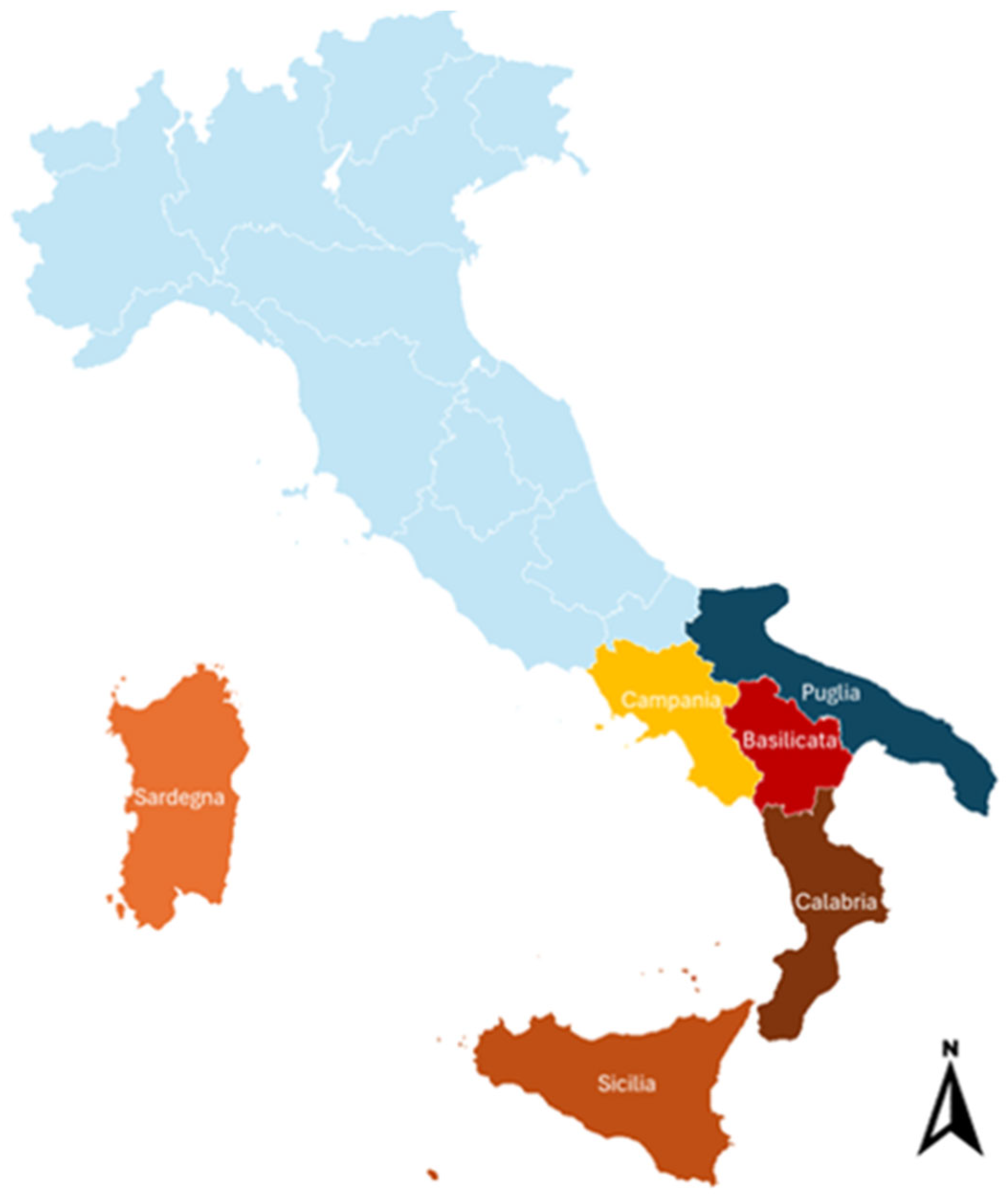
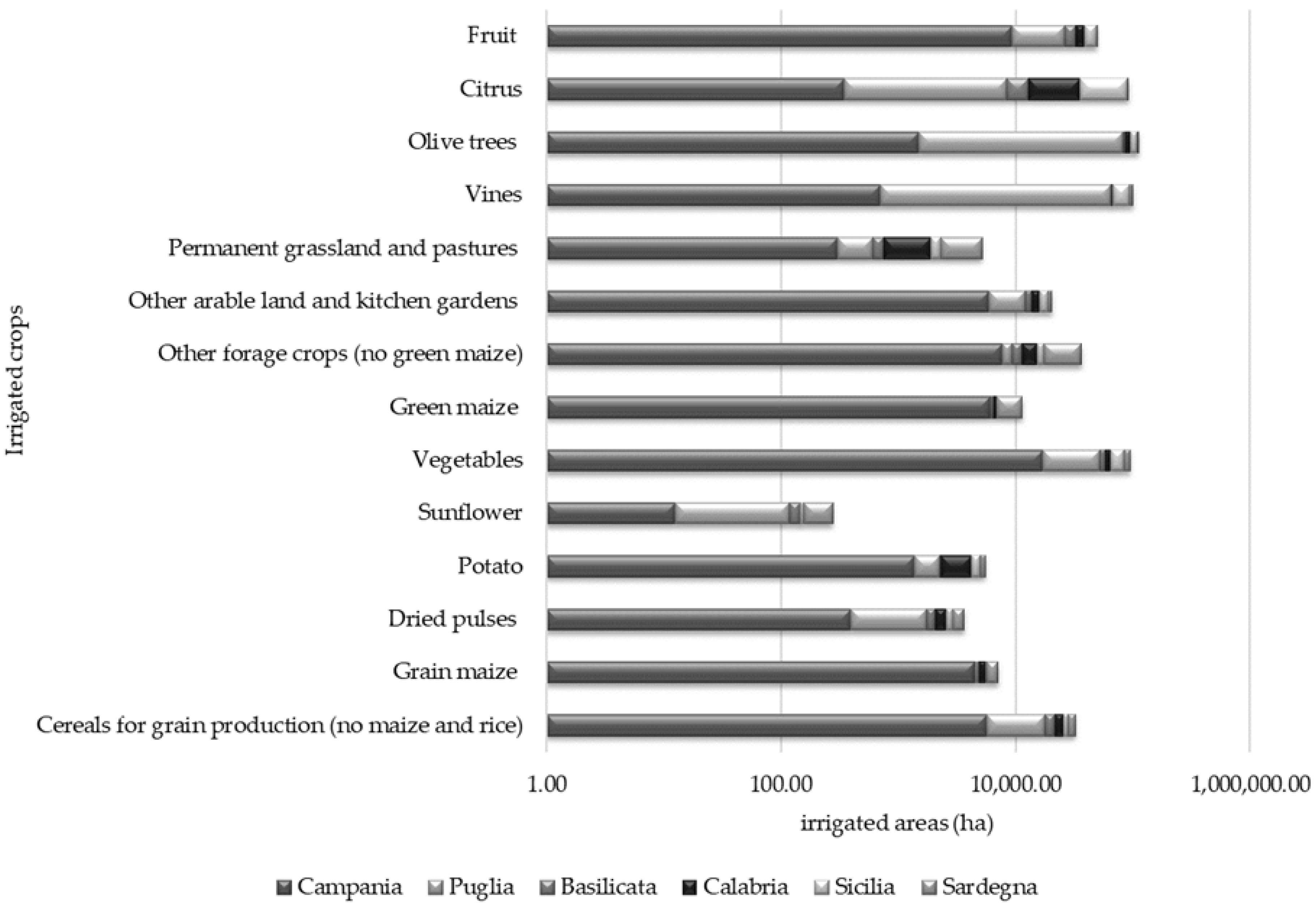

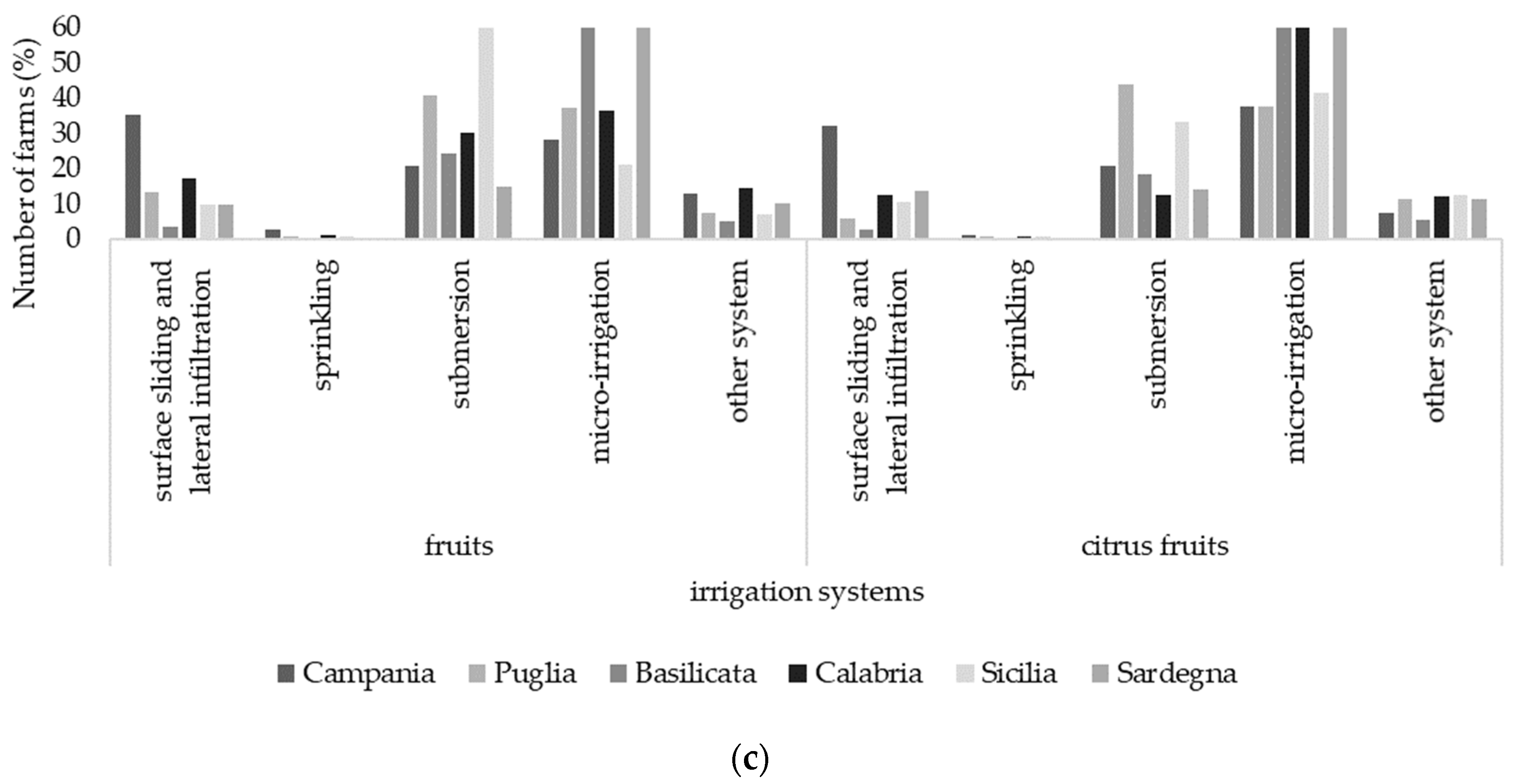


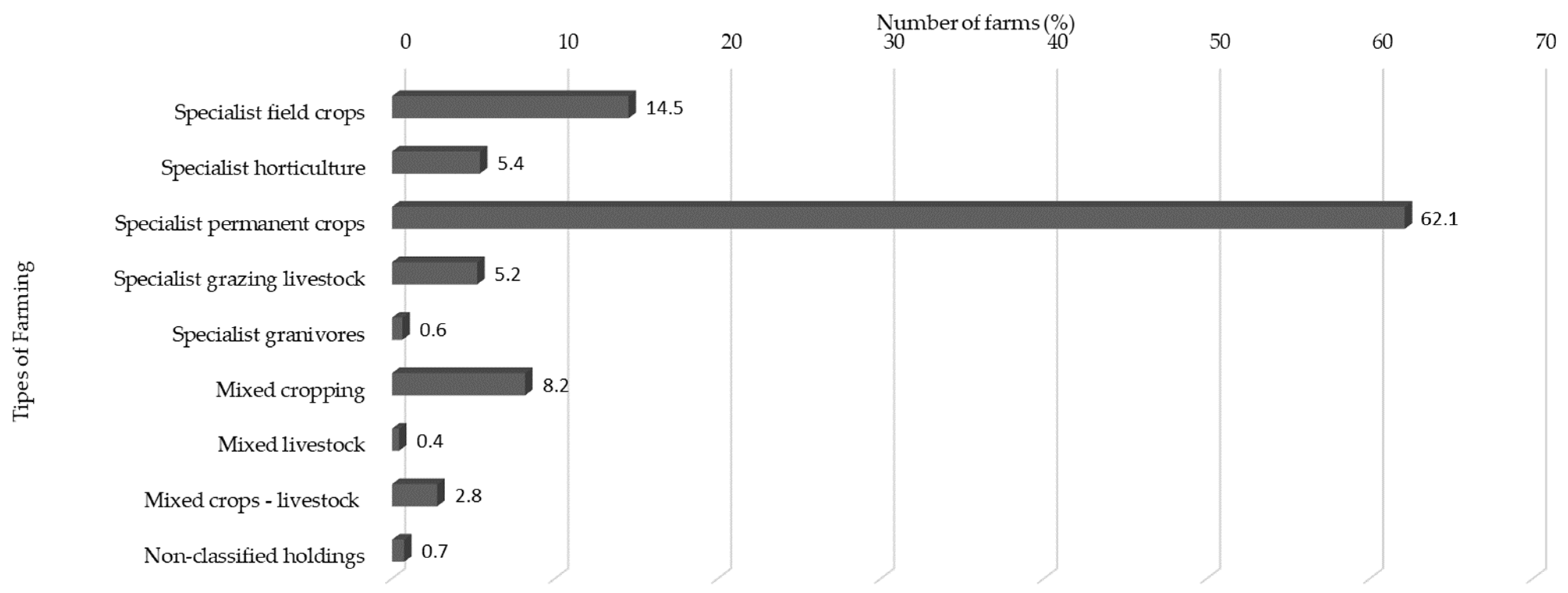

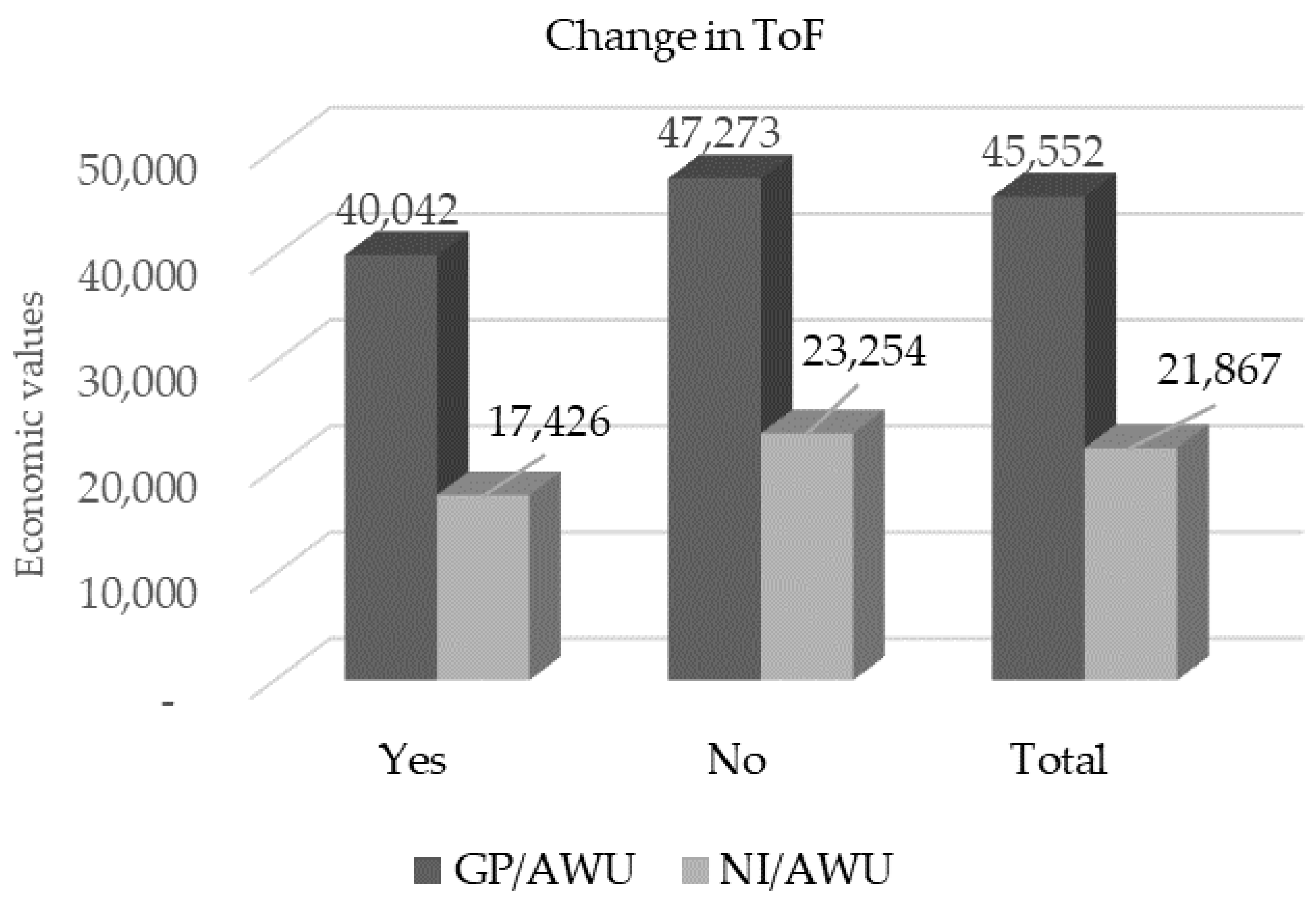
| Variables | Description |
|---|---|
| Dependent variable (logit model): | |
| Y | Dummy, 1 if farms change the type of farming; 0 if farms do not change the type of farming |
| Independent variable | |
| Year | Accounting years |
| Altimetry | Breakdown of farms according to altitude: mountains, hills, plains |
| Region | Administrative region where the farms are located (NUTS 2 region) |
| Type of farming (TOF) | Production specialization of the farm |
| Economic size group (ES) | Economic size of farms, measured through the Standard Output |
| Utilized agricultural area (UAA) | Area used for farming, measured in hectares |
| Livestock units (LSU) | Aggregation of livestock from various species and age as per convention |
| Power of machines (KW) | Power of the machines available per farm and measured in kW |
| Family working units (FWU) | Amount of family work performed in the year. It is equal to 2200 h per year |
| Management form | Type of farm management |
| Legal form | Type of legal form of the farms (e.g., individual, cooperative, company) |
| Organic Irrigation | Indicates whether the farm has implemented organic farming techniquesIndicates the presence of irrigation in the farm |
| Diversification | Indicates the presence of other gainful activities on the farm |
| Age | Farmer’s age, in years |
| Gender | Farmer’s gender (male, female) |
| Level of education | Farmer’s education level (primary school, secondary school, high school, degree) |
| GSP | Gross Saleable Production (GSP) (euros) |
| Subsidies | Public support received by farms, in euros |
| Other gainful activities (OGA) | Multifunctionality of a farm refers to the revenues generated from its multifunctional activities (euros) |
| Specific costs | Sum of the expenses for the purchase of non-farm consumption factors, other miscellaneous expenses and third-party services (euros) |
| Multi-year costs | Costs incurred for the purchase of goods that exhaust their usefulness in several financial years, only the quota pertaining to the year is considered (euros) |
| Distributed incomes | Sum of the expenses for wages and social security charges and passive rent (euros) |
| Farm net income (FNI) | The overall economic result of the farm, which identifies the ability to remunerate all the production factors used in the farm. Represents the dependent variable (euros) |
| Regions | Irrigated Farms (n.) | % | Irrigated Area (ha) |
|---|---|---|---|
| Campania | 24,922 | 17.1 | 60,876 |
| Puglia | 44,613 | 30.6 | 228,663 |
| Basilicata | 8036 | 5.5 | 29,857 |
| Calabria | 20,578 | 14.1 | 61,536 |
| Sicilia | 34,888 | 23.9 | 134,928 |
| Sardegna | 12,675 | 8.7 | 62,228 |
| Total | 145,712 | 100.0 | 578,088 |
| ToF 2010 | ToF 2020 | |||||||||
|---|---|---|---|---|---|---|---|---|---|---|
| Specialist Field Crops | Specialist Horticulture | Specialist Permanent Crops | Specialist Grazing Livestock | Specialist Granivores | Mixed Cropping | Mixed Livestock | Mixed Crops–Livestock | Non-Classified Holdings | Total | |
| Specialist field crops | 8214 | 833 | 2050 | 335 | 81 | 2036 | 48 | 390 | 191 | 14,178 |
| Specialist horticulture | 769 | 2732 | 379 | 14 | 9 | 373 | 3 | 20 | 18 | 4317 |
| Specialist permanent crops | 1692 | 450 | 55,764 | 153 | 101 | 2905 | 50 | 564 | 288 | 61,967 |
| Specialist grazing livestock | 744 | 21 | 209 | 3958 | 41 | 220 | 152 | 653 | 31 | 6029 |
| Specialist granivores | 21 | 2 | 25 | 8 | 93 | 10 | 14 | 17 | 1 | 191 |
| Mixed cropping | 1271 | 349 | 2941 | 94 | 24 | 1888 | 19 | 242 | 50 | 6878 |
| Mixed livestock | 33 | 13 | 107 | 18 | 24 | 41 | 61 | 2 | 299 | |
| Mixed crops–livestock | 328 | 17 | 316 | 344 | 25 | 257 | 56 | 564 | 9 | 1916 |
| Non-classified holdings | 198 | 18 | 160 | 8 | 1 | 42 | 3 | 32 | 462 | |
| Total | 13,270 | 4422 | 61,857 | 5021 | 393 | 7755 | 383 | 2514 | 622 | 96,237 |
| Variables | Coefficients | Standard Error | z-Statistic | Odds Ratio |
|---|---|---|---|---|
| Const | −1.13871 | 0.61931 | −1.84 | |
| Gender | 0.67782 | 0.18917 | 3.58 | 1.97 |
| Type of farming | 0.23691 | 0.05147 | 4.60 | 1.267 |
| Economic size class | −0.1191 | 0.08175 | −1.46 | 0.888 |
| Legal form | −1.06034 | 0.50303 | −2.11 | 0.346 |
| Organic | −0.36025 | 0.21032 | −1.71 | 0.698 |
| Utilized agricultural area | 0.0026 | 0.00177 | 1.47 | 1.003 |
| Livestock unit | −0.00747 | 0.00323 | −2.31 | 0.993 |
| R2 McFadden | 0.0559 | R2 adjusted | 0.041 | |
| Log-Likelihood | −503.852 | Akaike Criterion | 1023.7 | |
| Schwarz Criterion | 1062.34 | Hannan–Quinn Criterion | 1038.44 |
Disclaimer/Publisher’s Note: The statements, opinions and data contained in all publications are solely those of the individual author(s) and contributor(s) and not of MDPI and/or the editor(s). MDPI and/or the editor(s) disclaim responsibility for any injury to people or property resulting from any ideas, methods, instructions or products referred to in the content. |
© 2025 by the authors. Licensee MDPI, Basel, Switzerland. This article is an open access article distributed under the terms and conditions of the Creative Commons Attribution (CC BY) license (https://creativecommons.org/licenses/by/4.0/).
Share and Cite
Chiappini, S.; Cimino, O.; Cardillo, C. Climate Crises and Agricultural Drought: Evolutions in Water Scarcity Context at the Farm Level. Earth 2025, 6, 56. https://doi.org/10.3390/earth6020056
Chiappini S, Cimino O, Cardillo C. Climate Crises and Agricultural Drought: Evolutions in Water Scarcity Context at the Farm Level. Earth. 2025; 6(2):56. https://doi.org/10.3390/earth6020056
Chicago/Turabian StyleChiappini, Silvia, Orlando Cimino, and Concetta Cardillo. 2025. "Climate Crises and Agricultural Drought: Evolutions in Water Scarcity Context at the Farm Level" Earth 6, no. 2: 56. https://doi.org/10.3390/earth6020056
APA StyleChiappini, S., Cimino, O., & Cardillo, C. (2025). Climate Crises and Agricultural Drought: Evolutions in Water Scarcity Context at the Farm Level. Earth, 6(2), 56. https://doi.org/10.3390/earth6020056








